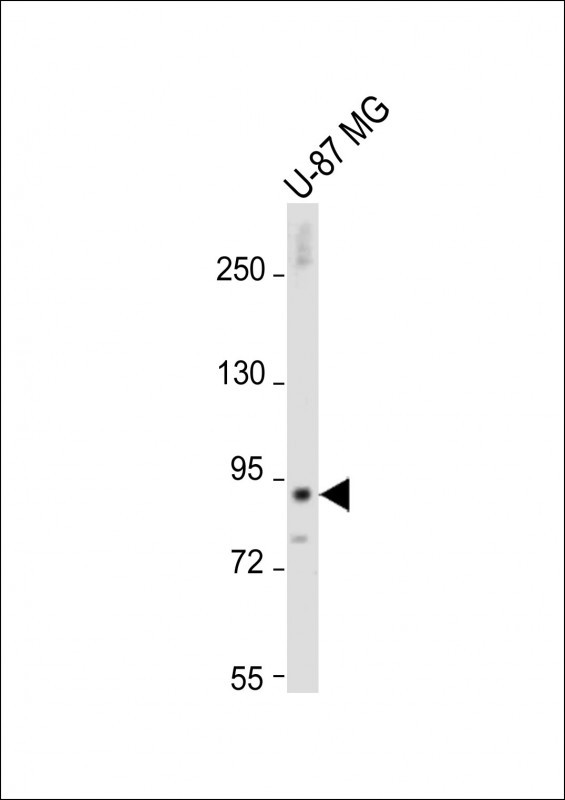
| WB | 咨询技术 | Human,Mouse,Rat |
| IF | 咨询技术 | Human,Mouse,Rat |
| IHC | 咨询技术 | Human,Mouse,Rat |
| ICC | 技术咨询 | Human,Mouse,Rat |
| FCM | 咨询技术 | Human,Mouse,Rat |
| Elisa | 咨询技术 | Human,Mouse,Rat |
| Aliases | Dystrobrevin alpha, DTN-A, Alpha-dystrobrevin, Dystrophin-related protein 3, DTNA, DRP3 |
| Entrez GeneID | 1837 |
| WB Predicted band size | 83.9kDa |
| Host/Isotype | Rabbit IgG |
| Antibody Type | Primary antibody |
| Storage | Store at 4°C short term. Aliquot and store at -20°C long term. Avoid freeze/thaw cycles. |
| Species Reactivity | Human, Mouse |
| Immunogen | This DTNA antibody is generated from rabbits immunized with a KLH conjugated synthetic peptide between 692-721 amino acids from the C-terminal region of human DTNA. |
| Formulation | Purified antibody in PBS with 0.05% sodium azide. |
+ +
以下是关于DTNA(α-dystrobrevin)抗体的3篇示例文献及其摘要概括(注:文献为示例性质,具体内容可能需要通过学术数据库核实):
---
1. **文献名称**:*α-Dystrobrevin in the Development and Maintenance of Cardiac Function*
**作者**:Yamamoto H, et al.
**摘要**:研究通过DTNA抗体分析α-dystrobrevin在小鼠心脏组织中的表达,发现其缺失会导致心肌细胞结构异常和心律失常,提示DTNA在维持心脏肌节稳定性中起关键作用。
2. **文献名称**:*Antibody-Based Detection of α-Dystrobrevin in Muscular Dystrophy Patients*
**作者**:Blake DJ, et al.
**摘要**:利用特异性DTNA抗体对肌肉活检样本进行免疫组化分析,发现部分肌营养不良症患者存在α-dystrobrevin表达下调,可能与疾病严重程度相关。
3. **文献名称**:*Interaction of α-Dystrobrevin with Dystrophin in Skeletal Muscle*
**作者**:Peters MF, et al.
**摘要**:通过Western blot和免疫共沉淀实验(使用DTNA抗体),验证了α-dystrobrevin与肌营养不良蛋白的相互作用,并阐明其在肌细胞膜骨架组装中的分子机制。
---
**建议**:以上文献为示例,实际研究中请通过PubMed或Google Scholar以“α-dystrobrevin antibody”或“DTNA antibody”为关键词检索最新文献,并注意结合具体研究方向(如疾病模型、诊断应用等)。
Dystrobrevin-alpha (DTNA) is a cytoskeletal protein encoded by the DTNA gene, belonging to the dystrophin-associated protein complex (DAPC). It plays a critical role in maintaining structural integrity and signaling in muscle and non-muscle tissues. DTNA anchors the DAPC to the cell membrane, linking the extracellular matrix to the intracellular actin cytoskeleton, which is essential for stabilizing cell membranes during mechanical stress. Mutations in DTNA are associated with cardiomyopathy, muscular dystrophy, and neurological disorders, highlighting its functional importance.
Antibodies targeting DTNA are widely used in research to study its expression, localization, and interactions within tissues. They enable detection via techniques like Western blotting, immunohistochemistry, and immunofluorescence, aiding in the characterization of disease models and molecular pathways. For example, DTNA antibodies have helped identify reduced protein levels in cardiac tissue from heart failure patients, suggesting its role in cardiomyocyte stability. Additionally, these tools contribute to exploring DTNA's involvement in synaptic organization and its interaction with proteins like syntrophin and dystrophin. Commercial DTNA antibodies are typically validated for specificity in human, mouse, or rat samples, supporting both basic research and preclinical studies aimed at understanding DAPC-related pathologies.
×